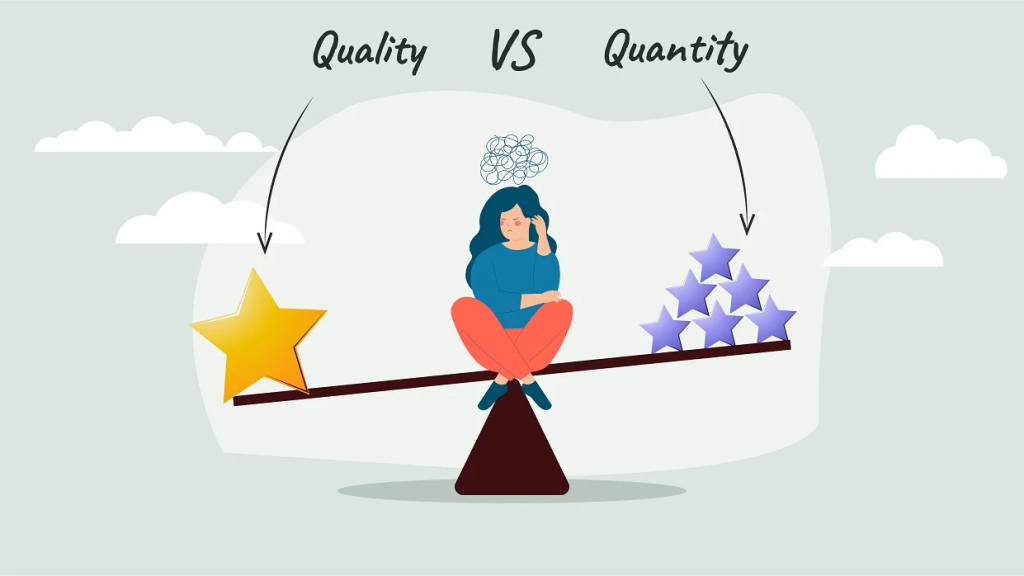Prioritizing Quality Over Quantity in Your Work
Megan Gray August 5, 2025
In today’s fast-paced world, businesses are constantly grappling with the pressure to produce more—more content, more products, more services. However, this “quantity over quality” mindset is starting to show its limits. In many industries, prioritizing quality over quantity has proven to be the most sustainable path to success. This shift is especially crucial in the business world, where customer expectations, long-term reputation, and effective strategies are of utmost importance. In this article, we’ll explore how businesses can thrive by focusing on the quality of their work rather than just churning out more, faster.

The Importance of Quality in Business
In business, quality doesn’t just refer to the end product; it spans across customer service, internal processes, employee satisfaction, and more. When you choose to prioritize quality, you set a foundation for lasting relationships with clients, partners, and employees. Quality assures your customers that their needs are being met and that your brand is reliable. As such, focusing on quality can increase customer retention and boost word-of-mouth recommendations, ultimately creating a loyal customer base that trusts your brand over time.
In a study conducted by Forbes, it was found that 86% of customers are willing to pay more for a better customer experience, highlighting how much consumers value quality service. Businesses that go the extra mile to provide superior products and services will always stand out in the crowded marketplace.
Quality vs. Quantity: The Hidden Costs of Excessive Production
Producing more doesn’t always equate to better results. In fact, focusing solely on quantity often leads to diminishing returns. Take the case of content creation, for example. The rise of content marketing has led many businesses to prioritize producing large volumes of blog posts, social media updates, or videos. However, simply churning out content without a focus on depth and relevance is ineffective. Businesses can quickly find themselves trapped in a cycle of content that doesn’t resonate with their target audience, leading to wasted resources and a dilution of brand credibility.
Likewise, in manufacturing, excessive production can lead to unsold inventory, increased operational costs, and logistical challenges. A greater quantity of products, if poorly designed or produced, can negatively affect your brand’s reputation. A product that lacks quality or is consistently flawed can be a significant deterrent to repeat customers. In contrast, producing fewer high-quality products can increase demand and reduce waste, allowing your company to focus on innovation and long-term growth.
How Quality Impacts the Bottom Line
Prioritizing quality is not just a feel-good business philosophy—it directly influences the financial success of your company. Here are a few ways that quality can benefit your bottom line:
- Reduced Customer Complaints: High-quality products or services are less likely to result in customer complaints. When customers are satisfied, they are less likely to return products or request refunds, which helps save costs in the long run. According to a report by McKinsey, businesses that maintain high-quality standards in their products are more likely to experience lower return rates, resulting in significant savings on logistics and customer service.
- Increased Brand Loyalty: Customers who receive excellent quality are more likely to become repeat buyers. They are also more likely to spread positive word-of-mouth, leading to organic brand growth. As quality leads to increased customer retention, businesses that focus on quality have a better chance of creating a stable and loyal customer base, which provides a solid foundation for future growth.
- Better Employee Engagement: Quality is not limited to the product or service—it also applies to the internal workings of a business. When businesses focus on creating a healthy work environment, offering skill development opportunities, and providing meaningful work, employees become more engaged and productive. A study by Gallup found that companies with high employee engagement see 17% higher productivity and 21% higher profitability, showcasing the clear link between quality internal practices and financial success.
- Long-Term Profitability: Although quality might seem like an upfront investment, its long-term benefits outweigh the initial costs. For instance, a company that invests in high-quality materials, ethical manufacturing practices, and rigorous quality control will see fewer defects, a longer product lifespan, and ultimately a higher customer lifetime value. By focusing on long-term sustainability rather than short-term gains, businesses can increase profitability over time while reducing risks.
Strategies to Prioritize Quality in Your Business
To make the shift from a quantity-based to a quality-focused mindset, businesses must take a strategic approach. Here are some steps that can help guide this transition:
1. Reevaluate Your Production Goals
Instead of simply setting production targets based on quantity, businesses should focus on how to enhance the quality of each product or service. This might mean reducing production volume while increasing quality control measures. For example, instead of pushing to produce 1,000 products a week, aim to produce 500 products of exceptional quality. This way, you can ensure that every product meets the standards your customers expect.
2. Leverage Customer Feedback
Customer feedback is one of the most valuable tools for improving quality. Regularly engage with customers through surveys, reviews, and social media. This can help identify pain points in your product or service offerings. Addressing these concerns with actionable improvements ensures that you are providing what your customers truly value.
3. Invest in Employee Training and Development
Employees are the backbone of any business, and their understanding of quality standards can directly influence how products are created and services are delivered. Invest in ongoing training programs to ensure your team has the necessary skills and knowledge to maintain high standards. Creating a culture of excellence begins with your employees.
4. Focus on Innovation
Quality can be further enhanced by continuously innovating and improving your offerings. Look for ways to streamline processes, incorporate new technologies, and embrace creative solutions. Innovation doesn’t always mean developing entirely new products—it can also involve improving existing products and services to meet the evolving needs of your customers.
5. Implement Rigorous Quality Control Measures
One of the most effective ways to prioritize quality is by implementing robust quality control measures at every stage of production. This could include pre-production testing, real-time monitoring, and post-production audits to ensure that your products meet the highest standards before reaching your customers.
The Power of a Quality-First Mindset
At the end of the day, the decision to prioritize quality over quantity is about establishing a sustainable and ethical approach to business. While producing more might seem like a quick win, focusing on quality delivers consistent results that benefit your customers, employees, and the bottom line. By shifting the focus away from just cranking out more work and placing an emphasis on superior outputs, businesses can build lasting value and success.
References
- Forbes (2021) Why Customer Experience is Key to Success. Available at: www.forbes.com (Accessed: 5 August 2025).
- McKinsey & Company (2020) The Value of Quality in Business. Available at: www.mckinsey.com (Accessed: 5 August 2025).
- Gallup. (2021) State of the Global Workplace Report. Available at: www.gallup.com (Accessed: 5 August 2025).







